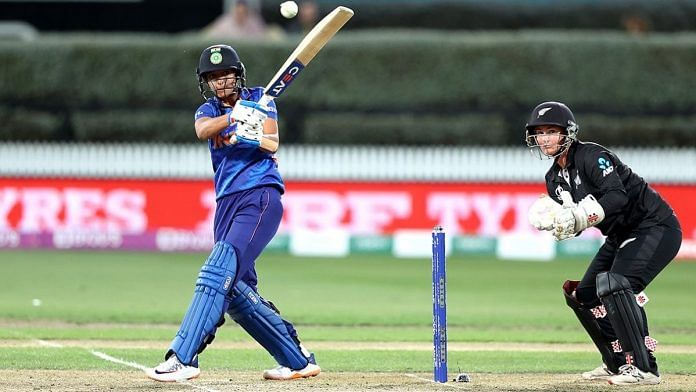New Delhi: Indian women’s euphoria after their 107-run decimation of Pakistan a few days ago came crashing down Thursday when they lost to New Zealand by 62 runs the first time in the ongoing Women’s World Cup at Hamilton’s Seddon Park.
The White Ferns’ win was achieved on the back of consistent economical bowling in the powerplay by the likes of Lea Tahuhu, Jess Kerr and Frances Mackay, after middle order batters Amelia Kerr, Amy Sattherthwaite and Katey Martin took them to a competitive score of 260-9.
Aside from disciplined death bowling from Pooja Vastrakar and Jhulan Goswami, and destructive power hitting from Harmanpreet Kaur and the tail, India came off second best in all aspects of the game and partly squandered its previously healthy net run rate.
With this defeat, India now sit in fifth place in the Women’s World Cup points table, and will face an in-form West Indies side in a tricky test at the same venue in two days’ time.
Although India have a good record against them, Stafanie Taylor’s side have already recorded two upsets in their first two games against New Zealand and defending champions England.
The first phase
The primary phase of the game in which the White Ferns thoroughly dominated India was in the first 20 overs of the second innings.
On a relatively slow pitch that offered less bounce and some assistance to both batters and seam bowlers, New Zealand captain Sophie Devine offered the new ball to off spinner Frances Mackay and medium pacer Jess Kerr to counter India’s left-handed top three.
While India had made the correct decision to drop out-of-form Shafali Varma and give the less experienced Yastika Bhatia a chance, the two openers’ batting styles and approaches were polar opposites.
Shafali is a dasher and attracted attention for her T20 performances for India and the Sydney Sixers, but Bhatia is more suited to a cautious anchor role with a career strike rate in the early seventies.
As a result, the responsibility to score quicker fell on Bhatia’s opening partner Smrithi Mandhana and no.3 batter Deepti Sharma. However, dot balls began piling up on both ends, as both Bhatia and Mandhana struggled to rotate the strike before Mandhana chipped a full ball from Kerr outside off stump to Suzie Bates.
Deepti fell soon after during Lea Tahuhu’s opening over, trapped in front of the stumps by her sharp bowling angle from wide of the crease.
This dismissal ultimately served as a blueprint for the rest of Tahuhu’s spell as she, Hayley Jensen and Hannah Rowe ensured that the entire Indian top order never looked comfortable at the crease.
Scoreboard pressure did India in
In the absence of any real aggressive intent against seam and swing, it appeared as if Bhatia and senior batters Mithali Raj and Harmanpreet Kaur were simply waiting for Devine to bring on spin in the middle overs.
But Devine held back leg-spinner Amelia Kerr and the rest of Mackay’s spell until the 25th over. By then, Bhatia had become Tahuhu’s second victim and the required run rate had ballooned from 5.22 to 7.50.
Both Mithali and Harmanpreet showed greater attempts to target boundaries, but the growing scoreboard pressure meant Mithali would have a wild attempt at a sweep shot to a full wide ball from Amelia Kerr, and be stumped by Katey Martin in the process.
Wicketkeeper Richa Ghosh fell to Kerr in the very next ball. Ghosh’s decision to try a cut shot at a googly that straightened and cannoned into off stump summed up the baffling approach made by the vast majority of India’s batters.
In the end, it was only Harmanpreet who read the match situation near-perfectly, scoring a run-a-ball half century and recovered some of India’s net run rate. But Harmanpreet along with Jhulan Goswami and Meghna Singh were left with too much to do in the final 10 overs.
Also read: Jhulan becomes joint-highest wicket taker in Women’s ODI World Cup






